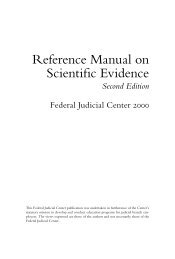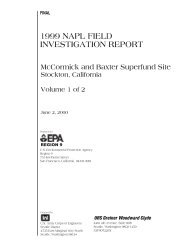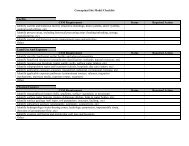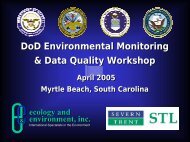Source Zone Delineation Demonstration Report - Triad Resource ...
Source Zone Delineation Demonstration Report - Triad Resource ...
Source Zone Delineation Demonstration Report - Triad Resource ...
Create successful ePaper yourself
Turn your PDF publications into a flip-book with our unique Google optimized e-Paper software.
The SVE system included piping from the extraction well to a demister tank (called the “wet side” on thefield logs) and from the demister tank through the rotometers (called the “dry side” on the field logs) intothe blower intake. A demister tank was plumbed into the system in the event that water entrained in thevadose zone was vacuumed to the surface. Sample ports were located on both the wet side and the dryside of the demister tank. Air samples were collected from the wet side of the SVE system to eliminatethe potential for TCE to partition to any accumulated water contained in the demister tank resulting inartificially low TCE concentrations measured in the extracted vapor. In the event water was conveyed tothe surface, samples would have been collected from the wet side and dry side for comparison purposes.However, water was not encountered during the vapor extraction operations conducted at the OU 12 siteduring the demonstration. The demister tank was eventually removed during extraction at U12-VP5when the vacuum relief valve on the demister malfunctioned at a vacuum of 77 inches of water measuredat the blower. The demister tank was removed and the SVE process system was re-plumbed with PVCpipe.Measurements of the effects of SVE on the subsurface were conducted through use of rotometers formeasurement of air flow at the extraction well head, use of a vacuum gauge for measurement of vacuumat the well head, and use of differential pressure gauges for measurement of vacuum induced at themonitoring wells. A process and instrumentation diagram of the SVE process system is shown in Figure4-5. The field-portable SVE process system, extraction/monitoring probe completions, and DSITMS withair module are shown in Figure 4-6. Table 4-2 provides a summary of the instrumentation utilized duringthe SVE demonstration at the OU 12 site. Prior to field operations, the SVE process system was checkedunder pressure and vacuum for leaks.Two blowers were used separately to induce airflow from the extraction well and produce a response atthe monitoring wells. The first blower was a 1 horsepower REGENAIR TM blower with a rated (atstandard temperature and pressure) free airflow of 92 cubic feet per minute (cfm) and a maximumvacuum of 48 inches of water. This blower was used to sweep vapor from relatively small volumes of thevadose zone to produce chemical data that serve as input to the numerical model. This blower allowedoperation at low vacuum that was increased in steps until the pneumatic permeability of the affected areacontrolled the blower operation. Initially, the air dilution valve was opened to the atmosphere at the startof the operation and the blower was operated at minimum vacuum. The air dilution valve was closed insmall increments (steps) and the vacuum/flow was recorded in the SVE header. Eventually, the dilutionvalve was closed to the atmosphere and full available vacuum (discounting pressure losses in the pipesand the well) was applied to the vadose zone. The step test was continued at higher vacuum and flowusing a second 3 horsepower REGENAIR TM blower whose capacity at standard temperature and pressurewas rated at a flow of 147 cfm and a vacuum of 90 inches of water. Prior to the start of each step test atthe soil vapor extraction points, a low-flow (approximately 200 ml/min) sample pump was used toextraction the soil gas in the immediate vicinity of the well. The sample pump also was used near thecompletion of each step test to evaluate TCE rebound during periods when the blower was shut down. Asummary of the step tests conducted at each soil monitoring/extraction location is shown in Table 4-3.March 2003 4-7 OU 12 <strong>Demonstration</strong> <strong>Report</strong>Final










